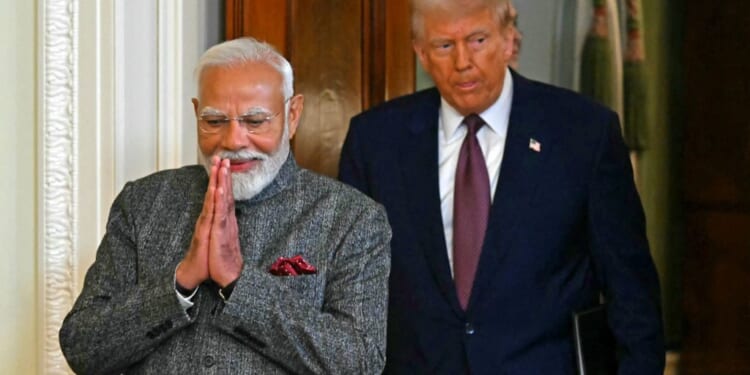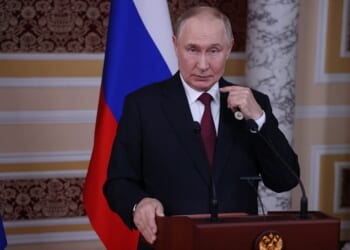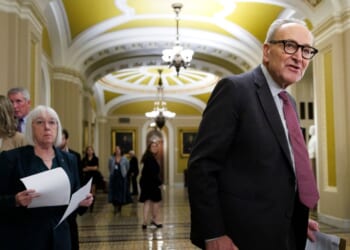We could call it the Big Beautiful Blunder — the ultimate diplomatic error of modern American history. First, the Biden administration inadvertently drove China and Russia closer together through sanctions and tariffs. Now, the Trump administration is driving India and Indonesia deeper into the China-Russia bloc.
The Indians don’t complain as much about Donald Trump as the Europeans do; instead, they’ve treated his tariffs as a wake-up call to reduce their reliance on the US. I am writing this column from New Delhi, where I have met with senior Indian politicians and economists. The big theme here is India’s deeper integration into the Bric group and with the countries of South East Asia. (Brics stands for Brazil, Russia, India, China and South Africa, but the group has recently expanded to include five other countries, including Indonesia and Saudi Arabia.) This strategy is not entirely new: India was already doing business with Russia, which provides its oil and military hardware. And it will continue to do so. But the dial has certainly shifted.
Perhaps the most extraordinary shift is regarding India’s relationship with China. The two nations have long been engaged in a dispute over their unmarked border in the Himalayas. In 2020, 20 Indian and four Chinese soldiers died in clashes along the disputed border in the Galwan Valley in the northern-most part of India. Flights between the two countries were suspended when the Covid pandemic struck and were never resumed. Since then, relations appear to have improved. Last Thursday, India’s largest budget airline, IndiGo, announced it would restart daily flights between Kolkata and Guangzhou. During the Shanghai Cooperation Organisation meeting in early September, China’s president Xi Jinping and India’s Prime Minister Narendra Modi started to patch up their relationship. They agreed to deescalate their border conflict, and to strengthen trade and investment ties. They both have more to gain from co-operation than from conflict.
For a long time, the joke among Western diplomats was that India’s role in the Brics was to keep a watchful eye on Russia and China, and make sure that the two were not getting too close. If that indeed was the plan, it has proven little more than Western wishful thinking. Together, the Brics’ economies are already larger than America’s, Europe’s and Japan’s combined, if you measure their economies in purchasing power as the World Bank does. According to that metric, China and India are the world’s largest and third-largest economies respectively. Each year, they are growing larger relative to the West. Two years ago, Modi set a target for India to achieve developed-nation status by 2047, the centenary of the country’s independence. To achieve it, India would need to grow by 8% every year. It’s not quite there yet — but it’s growing fast.
“The joke among Western diplomats was that India’s role in the Brics was to keep a watchful eye on Russia and China”
I suspect that the folk in the US State Department and the Western foreign policy community are clinging on to statistics that measure the size of an economy in US dollars. According to that metric, the US is still top dog — and the combined West is far larger than the Brics. That metric has its economic merits, but it does not account for geopolitics. As part of its sanctions, the West cut Russia off from the dollar markets. China has capital controls. Dollars do not flow freely in and out of these countries. This is why you shouldn’t measure their economies in dollars, but in terms of what their local currencies buy. That’s what purchasing-power parity, or PPP, measures — the “bang for the buck”, in Russia’s case quite literally. The reason Western experts critically misjudged Russia’s capacity to build weapons and to sustain its war in Ukraine is because of their attachment to wrong statistics. If they had looked at PPP, they would have recognised Russia for what it really is: the fourth-largest economy in the world, larger than Germany and Japan.
In the West, delusions also persist about China’s strategy. I recently heard a former Biden administration official boasting about a conversation he had with President Xi, who assured him that China did not support Russia’s war against Ukraine. How could he be so credulous? Perhaps because virtually all geopolitical commentary in the West is deeply afflicted by confirmation bias. The South China Morning Post came closer to the truth when it quoted Wang Yi, China’s foreign minister, telling a European official that China wants Russia to keep on fighting in Ukraine to prevent Washington shifting its focus to Beijing.
Through his trade policies, Trump has driven the Brics countries, and parts of the Global South, closer together. Before Trump’s second term, the US was everyone’s favourite trading partner. It had a huge economy, with a single market and no internal trade barriers. Trump’s tariffs changed the picture. My interlocutors in Delhi were all talking about how Asian countries could trade more with one another to replace the trade with America that is now lost.
They also want to reduce their reliance on the US dollar. This would be a very big deal. But it is easier said than done and will require time. You need a sophisticated financial infrastructure to do this. Currently, India and Brazil conduct most of their trade through US dollars as the vehicle currency, since the US has a mature financial infrastructure and deep capital markets. If they were to wean themselves off the US dollar, the Indians selling goods to Brazil would have to hold the money in the form of Brazilian reals. And the Brazilians would have to hold Indian rupees. This is not at present hugely convenient. But, with their sanctions and tariffs, Biden and Trump have encouraged the Bric countries to move towards trading in local currencies.
The Brics have already started to develop a payment system, Brics Pay, which is based on the same technology as crypto currencies. When it’s finally ready to be rolled out, it will make it easier, cheaper and faster for member countries to pay each other in their own currencies. The real appeal of Brics Pay, however, is that the more you can shift your invoicing into local currencies, the less vulnerable you become to US sanctions. In recent years, the US has used its dominance of global financial markets as a weapon to impose its political will on other countries — largely by threatening to cut off local banks from the US dollar markets. Even China is not immune to this. Right now, the US still enjoys what is known as an exorbitant privilege, but it is a privilege that depletes each time it is used.
Where do the Europeans fit into this picture? The EU and India are currently negotiating a trade deal that is due to be wrapped up by the end of the year. A deal could help both parties to reduce their dependence on the US. Yet there are still big issues to be sorted out in the next round of talks later this month, including Indian duties on cars, and compliance with climate targets.
Even if the deal is agreed, I doubt it will be a game-changer for India. A trade deal with the EU could help India nudge up its growth rates a little. But real change will come from within. India’s bigger game is high tech, and AI will be a big driver of economic growth. European governments talk about AI as if it’s some kind of eccentric American thing. Meanwhile, the Indians have made concrete plans to use AI to improve the productivity of manufacturing. That’s where the future growth will come from. Intra-Asian trade will become more important, but we must not forget that large economies, such as the US or India, derive most of their growth internally. They are not as reliant on trade as European countries typically are.
Once India reduces its dependency on the US, it will not go back to the old days even if Trump is replaced by a Democrat. The US will remain an important power for a long time, with unmatched military strength. China will be the dominant power of the Eurasian continent, supported by Russia. India will play its own game. The Europeans will be stuck between those two systems. They have no strategy of their own to prosper in a world that is becoming less America-centric.
What perhaps left the deepest impression on me during my trip to India was the degree of strategic patience at play. Modi set his economic goal for 2047. China also thinks in terms of timelines way beyond policy horizons in the West. In his 2011 book On China, Henry Kissinger wrote about the Chinese premier: “When asked about the impact of the French Revolution, Zhou Enlai replied: ‘It is too early to tell.’” I always thought of Zhou Enlai’s comment as a joke about how the Chinese think. These days, I am no longer so sure. He might have been dead serious.

















